Science
(www.olympiadsuccess.com)
Chapter 7: Diversity in Living Organisms
Class: IX
Exemplar sheet 7
Multiple Choice Questions
Question 1
Find out incorrect sentence
(a) Protista includes unicellular eukaryotic organisms
(b) Whittaker considered cell structure, mode and source of nutrition for classifying the organisms in five kingdoms
(c) Both Monera and Protista may be autotrophic and heterotrophic
(d) Monerans have well defined nucleus
Answer 1
(d)
Question 2
Which among the following has specialised tissue for conduction of water?
(i) Thallophyta
(ii) Bryophyta
(iii) Pteridophyta
(iv) Gymnosperms
(a) (i) and (ii)
(b) (ii) and (iii)
(c) (iii) and (iv)
(d) (i) and (iv)
Answer 2
(c)
Question 3
Which among the following produce seeds?
(a) Thallophyta
(b) Bryophyta
(c) Pteridophyta
(d) Gymnosperms
Answer 3
(d)
Question 4
Which one is a true fish?
(a) Jellyfish
(b) Starfish
(c) Dogfish
(d) Silverfish
Answer 4
(c)
Question 5
Which among the following is exclusively marine?
(a) Porifera
(b) Echinodermata
(c) Mollusca
(d) Pisces
Answer 5
(b)
Question 6
Which among the following have open circulatory system?
(i) Arthropoda
(ii) Mollusca
(iii) Annelida
(iv) Coelenterata
(a) (i) and (ii)
(b) (iii) and (iv)
(c) (i) and (iii)
(d) (ii) and (iv)
Answer 6
(a)
Question 7
In which group of animals, coelom is filled with blood?
(a) Arthropoda
(b) Annelida
(c) Nematoda
(d) Echinodermata
Answer 7
(a)
Question 8
Elephantiasis is caused by
(a) Wuchereria
(b) Pinworm
(c) Planarians
(d) Liver flukes
Answer 8
(a)
Question 9
Which one is the most striking or (common) character of the vertebrates?
(a) Presence of notochord
(b) Presence of triploblastic condition
(c) Presence of gill pouches
(d) Presence of coelom
Answer 9
(a)
Question 10
Which among the following have scales?
(i) Amphibians
(ii) Pisces
(iii) Reptiles
(iv) Mammals
(a) (i) and (iii)
(b) (iii) and (iv)
(c) (ii) and (iii)
(d) (i) and (ii)
Answer 10
(c)
Question 11
Find out the false statement
(a) Aves are warm blooded, egg laying and have four chambered heart
(b) Aves have feather covered body, fore limbs are modified as wing and breathe through lungs
(c) Most of the mammals are viviparous
(d) Fishes, amphibians and reptiles are oviparous
Answer 11
(d)
Question 12
Pteridophyta do not have
(a) root
(b) stem
(c) flowers
(d) leaves
Answer 12
(c)
Question 13
Identify a member of porifera
(a) Spongilla
(b) Euglena
(c) Penicillium
(d) Hydra
Answer 13
(a)
Question 14
Which is not an aquatic animal?
(a) Hydra
(b) Jelly fish
(c) Corals
(d) Filaria
Answer 14
(d)
Question 15
Amphibians do not have the following
(a) Three chambered heart
(b) Gills or lungs
(c) Scales
(d) Mucus glands
Answer 15
(c)
Question 16
Organisms without nucleus and cell organelles belong to
(i) fungi
(ii) protista
(iii) cyano bacteria
(iv) archae bacteria
(a) (i) and (ii)
(b) (iii) and (iv)
(c) (i) and (iv)
(d) (ii) and (iii)
Answer 16
(b)
Question 17
Which of the following is not a criterion for classification of living organisms?
(a) Body design of the organism
(b) Ability to produce one’s own food
(c) Membrane bound nucleus and cell organelles
(d) Height of the plant
Answer 17
(d)
Question 18
The feature that is not a characteristic of protochordata?
(a) Presence of notochord
(b) Bilateral symmetry and coelom
(c) Jointed legs
(d) Presence of circulatory system
Answer 18
(c)
Question 19
The locomotory organs of Echinodermata are
(a) tube feet
(b) muscular feet
(c) jointed legs
(d) parapodia
Answer 19
(a)
Question 20
Corals are
(a) Poriferans attached to some solid support
(b) Cnidarians, that are solitary living
(c) Poriferans present at the sea bed
(d) Cnidarians that live in colonies
Answer 20
(d)
Question 21
Who introduced the system of scientific nomenclature of organisms
(a) Robert Whittaker
(b) Carolus Linnaeus
(c) Robert Hooke
(d) Ernst Haeckel
Answer 21
(b)
Question 22
Two chambered heart occurs in
(a) crocodiles
(b) fish
(c) aves
(d) amphibians
Answer 22
(b)
Question 23
Skeleton is made entirely of cartilage in
(a) Sharks
(b) Tuna
(c) Rohu
(d) None of these
Answer 23
(a)
Question 24
One of the following is not an Annelid
(a) Nereis
(b) Earthworm
(c) Leech
(d) Urchins
Answer 24
(d)
Question 25
The book Systema Naturae was written by
(a) Linnaeus
(b) Haeckel
(c) Whittaker
(d) Robert Brown
Answer 25
(a)
Question 26
Karl Von Linne was involved with which branch of science?
(a) Morphology
(b) Taxonomy
(c) Physiology
(d) Medicine
Answer 26
(b)
Question 27
Real organs are absent in
(a) Mollusca
(b) Coelenterata
(c) Arthropoda
(d) Echinodermata
Answer 27
(b)
Question 28
Hard calcium carbonate structures are used as skeleton by
(a) Echinodermata
(b) Protochordata
(c) Arthropoda
(d) Nematoda
Answer 28
(a)
Question 29
Differentiation in segmental fashion occurs in
(a) Leech
(b) Starfish
(c) Snails
(d) Ascaris
Answer 29
(a)
Question 30
In taxonomic hierarchy family comes between
(a) Class and Order
(b) Order and Genus
(c) Genus and Species
(d) Division and Class
Answer 30
(b)
Question 31
5-Kingdom classification has given by
(a) Morgan
(b) R. Whittaker
(c) Linnaeus
(d) Haeckel
Answer 31
(b)
Question 32
Well defined nucleus is absent in
(a) blue green algae
(b) diatoms
(c) algae
(d) yeast
Answer 32
(a)
Question 33
The ‘Origin of Species’ is written by
(a) Linnaeus
(b) Darwin
(c) Hackel
(d) Whittaker
Answer 33
(b)
Question 34
Meena and Hari observed an animal in their garden. Hari called it an insect while Meena said it was an earthworm. Choose the character from the following which confirms that it is an insect.
(a) Bilateral symmetrical body
(b) Body with jointed legs
(c) Cylindrical body
(d) Body with little segmentation
Answer 34
(b)
Short Answer Questions
Question 35
Write true (T) or false (F)
(a) Whittaker proposed five kingdom classification.
(b) Monera is divided into Archaebacteria and Eubacteria.
(c) Starting from Class, Species comes before the Genus.
(d) Anabaena belongs to the kingdom Monera.
(e) Blue green algae belongs to the kingdom Protista.
(f) All prokaryotes are classified under Monera.
Answer 35
(a) T (b) T (c) F (d) T (e) F (f) T
Question 36
Fill in the blanks
(a) Fungi shows———mode of nutrition.
(b) Cell wall of fungi is made up of ———.
(c) Association between blue green algae and fungi is called as———.
(d) Chemical nature of chitin is ———.
(e) ———has smallest number of organisms with maximum number of similar characters
(f) Plants without well differentiated stem, root and leaf are kept in ———.
(g) ———are called as amphibians of the plant kingdom.
Answer 36
(a) saprophytic (b) chitin (c) lichens (d) carbohydrate
(e) species (f) thallophyta (g) bryophytes
Question 37
You are provided with the seeds of gram, wheat, rice, pumpkin, maize and pea. Classify them whether they are monocot or dicot.
Answer 37
Gram—dicot Wheat—monocot Rice—monocot,
Pumpkin—dicot Maize—monocot Pea—dicot
Question 38
Match items of column (A) with items of column (B)
(A) (B)
(a) Naked seed (A) Angiosperms
(b) Covered seed (B) Gymnosperms
(c) Flagella (C) Bryophytes
(d) Marchantia (D) Euglena
(e) Marsilea (E) Thallophyta
(f) Cladophora (F) Pteridophyta
(g) Penicillium (G) Fungi
Answer 38
(a)—B; (b)—A; (c)—D; (d)—C; (e)—F; (f)—E, (g)—G
.
Question 39
Match items of column (A) with items of column (B)
(A) (B)
(a) Pore bearing animals (A) Arthropoda
(b) Diploblastic (B) Coelenterata
(c) Metameric segmentation (C) Porifera
(d) Jointed legs (D) Echinodermata
(e) Soft bodied animals (E) Mollusca
(f) Spiny skinned animals (F) Annelida
Answer 39
(a)—C; (b)—B; (c)—F; (d)—A; (e)—E; (f)—D
Question 40
Classify the following organisms based on the absence/presence of true coelom (i.e., acoelomate, pseudocoelomate and coelomate)
Spongilla, Sea anemone, Planaria, Liver fluke Wuchereria, Ascaris, Nereis, Earthworm, Scorpion, Birds, Fishes, Horse.
Answer 40
Spongilla —Acoelomate
Sea anemone—Acoelomate
Planaria—Acoelomate
Liver fluke—Acoelomate
Wuchereria—Pseudocoelomate
Ascaris—Psudocoelomate
Nereis—Coelomate
Scorpion—Coelomate
Earthworm—Coelomate
Birds, Fishes and Horse—Coelomate
Question 41
Endoskeleton of fishes are made up of cartilage and bone; classify the following fishes as cartilagenous or bony
Torpedo, Sting ray, Dog fish,
Rohu, Angler fish, Exocoetus.
Answer 41
Torpedo—Cartilagenous, Sting ray—Cartilagenous, Dog fish— Cartilagenous,
Rohu—Bony, Angler fish— Cartilagenous Exocoetus—bony.
Question 42
Classify the following based on number of chambers in their heart. Rohu, Scoliodon, Frog, Salamander, Flying lizard, King Cobra, Crocodile, Ostrich, Pigeon, Bat, Whale
Answer 42
Rohu, Scoliodon— 2 chambered.
Frog, Salamander, Flying lizard, King Cobra—3 chambered.
Crocodile, Ostrich, Pigeon, Bat, Whale—4 chambered.
Question 43
Classify Rohu, Scolidon, Flying lizard, King Kobra, Frog, Salamander, Ostrich, Pigeon, Bat, Crocodile and Whale into the cold blooded/warm blooded animals.
Answer 43
Cold blooded— Rohu, Scoliodon, Frog, Salamander, Flying Lizard, King Cobra, Crocodile,
Warm blooded— Ostrich, Pigeon, Bat, Whale.
Question 44
Name two egg laying mammals.
Answer 44
(i) Platypus (ii) Echidna
Question 45
Fill in the blanks
(a) Five kingdom classification of living organisms is given by ———.
(b) Basic smallest unit of classification is ———.
(c) Prokaryotes are grouped in Kingdom ———.
(d) Paramecium is a protista because of its ———.
(e) Fungi do not contain ———.
(f) A fungus ——— can be seen without microscope.
(g) Common fungi used in preparing the bread is ———.
(h) Algae and fungi form symbiotic association called ———.
Answer 45
(a) Robert Whittaker
(b) Species
(c) Monera
(d) Eukaryotic unicellular organisms
(e) Chlorophyll
(f) Mushroom
(g) Yeast
(h) Lichens
Question 46
Give True (T) and False (F)
(a) Gymnosperms differ from Angiosperms in having covered seed.
(b) Non flowering plants are called Cryptogamae.
(c) Bryophytes have conducting tissue.
(d) Funaria is a moss.
(e) Compound leaves are found in many ferns.
(f) Seeds contain embryo.
Answer 46
(a) False (b) True (c) False (d) True (e) True (f) True
Question 47
Give examples for the following
(a) Bilateral, dorsiventral symmetry is found in———.
(b) Worms causing disease elephantiasis is———.
(c) Open circulatory system is found in———where coelomic cavity is filled with blood.
(d) ———are known to have pseudocoelom.
Answer 47
(a) Liver fluke
(b) Filarial worm
(c) Arthropods
(d) Nematodes
Question 48
Label a,b,c and d. given in Fig. 7.1 Give the function of (b)
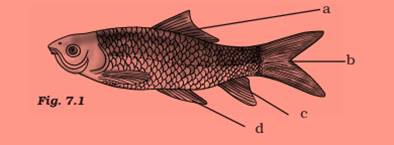
Answer 48
(a) Dorsal fin
(b) Caudal fin
(c) Pelvic fin
(d) Pectoral fin
Function of Caudal fin–Caudal fin helps in streamlined movement in water.
Question 49
Fill in the boxes given in Fig. 7.2 with appropriate characteristics/plant group (s)
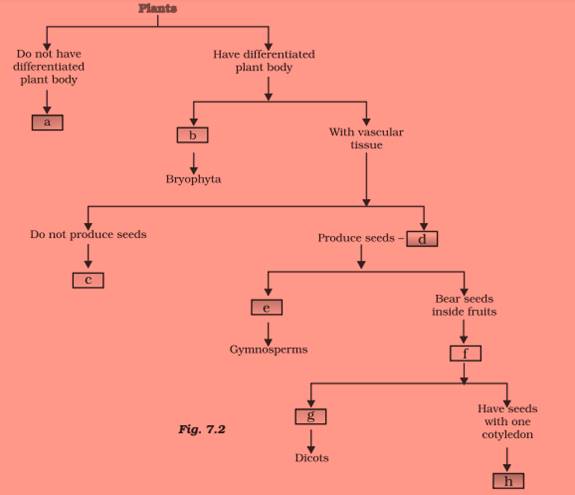
Answer 49
(a) Thallophyta
(b) Without specialized vascular tissue
(c) Pteridophyta
(d) Phanerogams
(e) Bear naked seeds
(f) Angiosperms
(g) Have seeds with two cotyledons
(h) Monocots
Long Answer Questions
Question 50
Write names of few thallophytes. Draw a labelled diagram of Spirogyra.
Answer 50
Ulothrix, Spirogyra, Cladophara, Ulva and Chara,
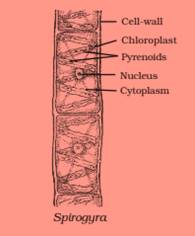
Question 51
Thallophyta, bryophyta and pteridophyta are called as ‘Cryptogams’. Gymnosperms and Angiosperms are called as ‘phanerogams’. Discuss why? Draw one example of Gymnosperm.
Answer 51
The Thallophyta, bryophyta and pteridophyta are called as ‘Cryptogams’ because the reproductive organs of these groups are inconspicuous or hidden. Seeds are absent. On the other hand ‘Phanerogams’ include gymnosperms and angiosperms which have well differentiated reproductive tissue and the embryo with stored food. Embryo develops into seed.
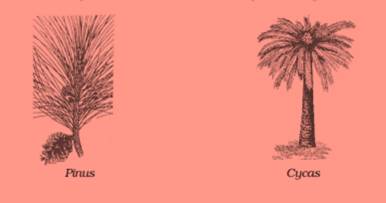
Question 52
Define the terms and give one example of each
(a) Bilateral symmetry
(b) Coelom
(c) Triploblastic
Answer 52
(a) The left and right halves of the body have the same design, eg, liver fluke
(b) Coelom is the internal body cavity between visceral organs and body wall in which well developed organs can be accommodated, eg. butterfly
(c) Animals having three layers of cells from which differentiated tissue can be made are called triploblastic, eg. star fish
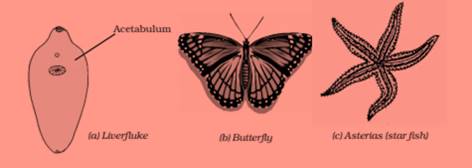
Question 53
You are given leech, Nereis, Scolopendra, prawn and scorpion; and all have segmented body organisation. Will you classify them in one group? If no, give the important characters based on which you will separate these organisms into different groups.
Answer 53
All organisms given in the question do not belong to same group. Leech and Nereis belong to phylum annelida because they have metamerically segmented body i.e., body is divided into many segments internally by septa. Body segments are lined up one after the other from head to tail. But Scolopendra, prawn and scorpion belong to phylum arthropoda as these have jointed legs and open circulating system.
Question 54
Which organism is more complex and evolved among Bacteria, Mushroom and Mango tree. Give reasons.
Answer 54
Hint— Mango tree is more complex and evolved than the other two because, it is autotrophic, eukaryotic, terrestrial sporophyte with covered seed. The bacteria is unicellular prokaryote and fungi are the heterotrophic, simple thallophyte with no tissue systems.
Question 55
Differentiate between flying lizard and bird. Draw the diagram.
Answer 55
Flying lizard belongs to reptiles. They are cold blooded, and their body is covered with scales. Their heart is three chambered. Birds belongs to group aves. They are warm blooded and body is covered with feathers, their forelimbs modified as wings and they heart is four chambered.
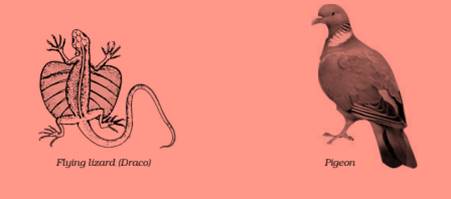
Question 56
List out some common features in cat, rat and bat.
Answer 56
Bat, rat and cat belong to class mammalia and have following common features
(a) All have notochord at some stage of life cycle.
(b) All are warm blooded.
(c) All have four chambered heart.
(d) All have skin covered with hair and with sweat and oil glands.
Question 57
Why do we keep both snake and turtle in the same class?
Answer 57
Hint— Because both are (1) cold blooded (2) have scales (3) breathe through lungs
(4) have three chambered heart, and (5) they lay eggs with tough covering.
Yearlong program for Olympiads preparation & to build necessary skills for future.
Explore More
Time to mark your calendar with the upcoming Olympiads exam schedule.
Explore More
Take your Olympiad preparation to next-level by taking LIVE Classes.
Explore More
Assess your performance by taking topic-wise and full length mock tests.
Explore More
Online tuitions for international compeitions like SASMO, SEAMO, etc for Grades 1-11.
Explore More